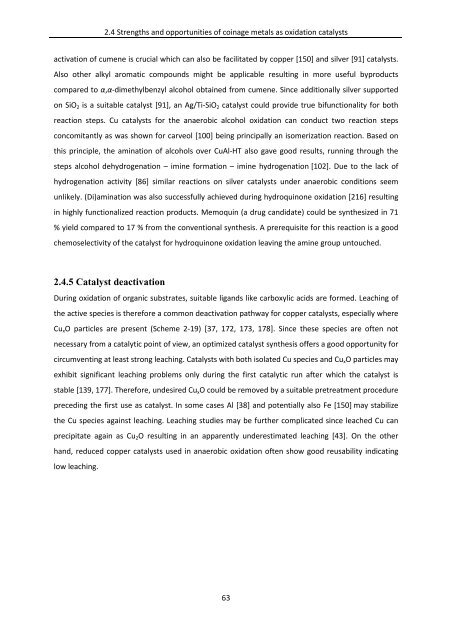Heterogeneously Catalyzed Oxidation Reactions Using ... - CHEC
Heterogeneously Catalyzed Oxidation Reactions Using ... - CHEC
Heterogeneously Catalyzed Oxidation Reactions Using ... - CHEC
Create successful ePaper yourself
Turn your PDF publications into a flip-book with our unique Google optimized e-Paper software.
2.4 Strengths and opportunities of coinage metals as oxidation catalysts<br />
activation of cumene is crucial which can also be facilitated by copper [150] and silver [91] catalysts.<br />
Also other alkyl aromatic compounds might be applicable resulting in more useful byproducts<br />
compared to α,α‐dimethylbenzyl alcohol obtained from cumene. Since additionally silver supported<br />
on SiO2 is a suitable catalyst [91], an Ag/Ti‐SiO2 catalyst could provide true bifunctionality for both<br />
reaction steps. Cu catalysts for the anaerobic alcohol oxidation can conduct two reaction steps<br />
concomitantly as was shown for carveol [100] being principally an isomerization reaction. Based on<br />
this principle, the amination of alcohols over CuAl‐HT also gave good results, running through the<br />
steps alcohol dehydrogenation – imine formation – imine hydrogenation [102]. Due to the lack of<br />
hydrogenation activity [86] similar reactions on silver catalysts under anaerobic conditions seem<br />
unlikely. (Di)amination was also successfully achieved during hydroquinone oxidation [216] resulting<br />
in highly functionalized reaction products. Memoquin (a drug candidate) could be synthesized in 71<br />
% yield compared to 17 % from the conventional synthesis. A prerequisite for this reaction is a good<br />
chemoselectivity of the catalyst for hydroquinone oxidation leaving the amine group untouched.<br />
2.4.5 Catalyst deactivation<br />
During oxidation of organic substrates, suitable ligands like carboxylic acids are formed. Leaching of<br />
the active species is therefore a common deactivation pathway for copper catalysts, especially where<br />
CuxO particles are present (Scheme 2‐19) [37, 172, 173, 178]. Since these species are often not<br />
necessary from a catalytic point of view, an optimized catalyst synthesis offers a good opportunity for<br />
circumventing at least strong leaching. Catalysts with both isolated Cu species and CuxO particles may<br />
exhibit significant leaching problems only during the first catalytic run after which the catalyst is<br />
stable [139, 177]. Therefore, undesired CuxO could be removed by a suitable pretreatment procedure<br />
preceding the first use as catalyst. In some cases Al [38] and potentially also Fe [150] may stabilize<br />
the Cu species against leaching. Leaching studies may be further complicated since leached Cu can<br />
precipitate again as Cu2O resulting in an apparently underestimated leaching [43]. On the other<br />
hand, reduced copper catalysts used in anaerobic oxidation often show good reusability indicating<br />
low leaching.<br />
63



